Potřebujeme váš souhlas k využití jednotlivých dat, aby se vám mimo jiné mohly ukazovat informace týkající se vašich zájmů. Souhlas udělíte kliknutím na tlačítko „OK“.
ASTM E601-15
Standard Guide for Measuring Electromotive Force (emf) Stability of Base-Metal Thermoelement Materials with Time in Air
Automaticky přeložený název:
Standardní Průvodce pro měření elektromotorická síla ( EMF) Stabilita základního kovu termoměniče Materiály s časem ve vzduchu
NORMA vydána dne 1.5.2015
Informace o normě:
Označení normy: ASTM E601-15
Poznámka: NEPLATNÁ
Datum vydání normy: 1.5.2015
Kód zboží: NS-591406
Počet stran: 7
Přibližná hmotnost: 21 g (0.05 liber)
Země: Americká technická norma
Kategorie: Technické normy ASTM
Kategorie - podobné normy:
Anotace textu normy ASTM E601-15 :
Keywords:
ICS Number Code 17.200.20 (Temperature-measuring instruments)
Doplňující informace
| Significance and Use | ||||||||||||
|
5.1 This test is important because the accuracy of a temperature measurement by a thermocouple is directly related to the emf stability of the thermoelements. 5.2 This test is used to verify that the tested thermoelements meet the intended requirements. 5.3 This test is useful in comparing the emf stability of two base metal thermoelements under the same conditions. The test and reference emf may be measured either simultaneously or alternately. 5.4 The relative stabilities of base metal thermoelements determined by this test are valid only under the specified test conditions. Results will be affected by changes in any of the following conditions: (1) temperature profile or gradient along the length of the thermoelements; (2) abundance, velocity and composition of the air surrounding the test pieces; (3) thermoelectric inhomogeneity of the test thermoelements; (4) stability of the platinum thermoelement. 5.5 The test does not address the determination of base metal thermoelement stabilities over a series of temperature changes. 5.6 The reliability of this test depends on the emf stability of the reference platinum thermoelement. For testing the relative emf stability of base-metal thermoelements, a reference element of platinum that has sufficient thermoelectric stability to determine any significant change in emf of base-metal thermoelements shall be used. To ascertain that the experimental method protects the platinum sufficiently from degradation, the method shall be validated by performing the procedure described in Appendix X1 prior to the actual test. 5.7 The test result does not apply to applications in which the temperature distribution, for a given measuring junction temperature, changes with time. |
||||||||||||
| 1. Scope | ||||||||||||
|
1.1 This guide provides a method for measuring the emf stability of base-metal thermoelement materials in air referenced to platinum at specified constant elevated temperatures using dual, simultaneous, emf indicators, or using a single emf indicator, with the test and reference emf measured alternately. This test is conducted over a period of weeks. 1.2 A calibrated platinum-rhodium/platinum thermocouple is used as a reference standard to establish the test temperature. 1.3 The useful life of a thermocouple depends on the stability of the emf generated at given temperatures for a required time interval. This method provides a quantitative measure of the stability of individual thermoelements. By combining the results of the positive (P) and negative (N) thermoelements, the stability of a thermocouple comprised of both P and N thermoelements may be obtained. The emf of an individual thermoelement is measured against platinum, which may be the platinum leg of the platinum-rhodium/platinum reference thermocouple, or an additional platinum reference. Note 1: Some thermoelements may show insignificant emf drift
while undergoing relatively rapid oxidation. In these cases,
failure of the thermoelement may be indicated only by a large rise
in the electrical resistance between joined thermoelements, as
measured at the reference junctions.
Note 2: See ASTM MNL 12 for recommended upper temperature
limits in air.Note 3: This guide is only applicable for initially new
thermoelements. Base-metal thermoelements exposed to temperatures
above 200°C become thermoelectrically inhomogeneous, and stability
testing of inhomogeneous thermoelements will give ambiguous
results.
1.4 This standard does not purport to address all of the safety concerns, if any, associated with its use. It is the responsibility of the user of this standard to establish appropriate safety and health practices and determine the applicability of regulatory limitations prior to use. |
||||||||||||
| 2. Referenced Documents | ||||||||||||
|
Podobné normy:
Historická
1.6.2013
Historická
1.4.2013
Historická
1.10.2014
Historická
1.5.2014
Historická
1.11.2011
Historická
1.5.2014


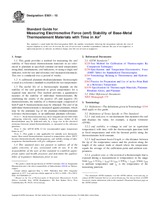
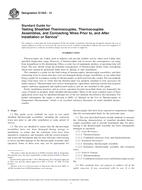 ASTM E1350-13
ASTM E1350-13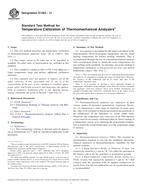 ASTM E1363-13
ASTM E1363-13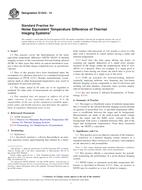 ASTM E1543-14
ASTM E1543-14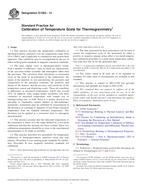 ASTM E1582-14
ASTM E1582-14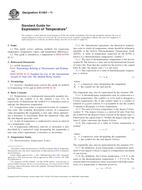 ASTM E1594-11
ASTM E1594-11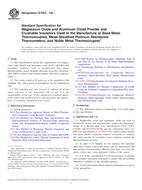 ASTM E1652-14a
ASTM E1652-14a
 Cookies
Cookies
